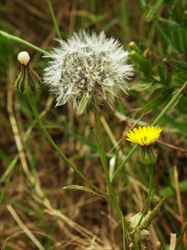Click on images to enlarge

By Michael Becker (taken by Michael Becker) [GFDL (http://www.gnu.org/copyleft/fdl.html) or CC-BY-SA-3.0 (http://creativecommons.org/licenses/by-sa/3.0/)], via Wikimedia Commons

By Alvesgaspar (Own work) [GFDL (http://www.gnu.org/copyleft/fdl.html), CC-BY-SA-3.0 (http://creativecommons.org/licenses/by-sa/3.0/) or CC BY 2.5 (http://creativecommons.org/licenses/by/2.5)], via Wikimedia Commons

By Michael Becker (taken by Michael Becker) [GFDL (http://www.gnu.org/copyleft/fdl.html) or CC-BY-SA-3.0 (http://creativecommons.org/licenses/by-sa/3.0/)], via Wikimedia Commons
Scientific Name
Hieracium murorum L.
Family
Asteraceae (Queensland, New South Wales, the ACT, Victoria, Tasmania, Western Australia and the Northern Territory)Compositae (South Australia)
Common Names
few-leaved hawkweed, golden lungwort, hawkweed, wall hawkweed
Origin
Native to Europe (i.e. Denmark, Finland, Ireland, the UK, Norway, Sweden, Austria, Belgium, Czechoslovakia, Germany, Hungary, the Netherlands, Poland, Switzerland, Belarus, Estonia, Latvia, Lithuania, Ukraine, Albania, Bulgaria, Greece, Italy, Romania, Yugoslavia, France, Portugal and Spain) and western Asia (i.e. Turkey, Armenia, Azerbaijan, Georgia and southern Russia).
Naturalised Distribution
Locally naturalised on the central tablelands of New South Wales.
Notes
Wall hawkweed (Hieracium murorum) is regarded as an emerging environmental weed in New South Wales and appears on the local bushland weed list for the Blue Mountains local authority. It is also seen as a potential environmental weed in other parts of south-eastern Australia.
This species was first reported as being naturalised in Australia in 2001, at Katoomba in the Blue Mountains. Like other hawkweeds (Hieracium spp.), it is a potentially serious weed of the tussock grasslands on the tablelands of south-eastern Australia. It spreads via creeping aboveground stems (i.e. stolons) and can create a dense mat of vegetation that practically eliminates all other ground vegetation.

